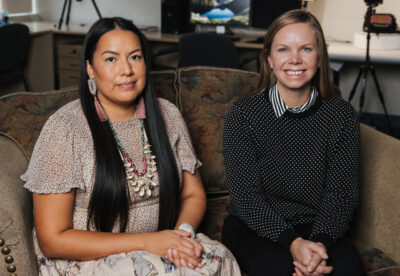Lecture series discusses cultural vitality tonight
By Theodora MacLeod - Lethbridge Herald Local Journalism Initiative Reporter on January 25, 2024.
 University of Lethbridge photo -
Melissa Shouting and Christine Clark will explore how the web is being reshaped in Indigenous worldviews for cultural revitalization, renewal and relationship building in their PUBlic Professor Series talk - Weaving World Views: The Web as a space for cultural vitality.
University of Lethbridge photo -
Melissa Shouting and Christine Clark will explore how the web is being reshaped in Indigenous worldviews for cultural revitalization, renewal and relationship building in their PUBlic Professor Series talk - Weaving World Views: The Web as a space for cultural vitality.Community members are being invited tonight to join Christine Clark, associate professor of web design and development at the University of Lethbridge in the department of new media, and Melissa Shouting, program coordinator and instructor for the Aboriginal Health program in the faculty of health sciences for the fourth installment of the University’s PUBlic Professor Series as they discuss “Weaving world views: The Web as a space for cultural vitality.”
The lecture runs from 7 – 9 p.m. at Sandman Signature Lethbridge Lodge on Scenic Drive South.
Clark and Shouting are part of a team using technology to make Blackfoot items held in European museums accessible to the community through the Mootookakio’ssin research project. Utilizing RTI (Reflectance Transformation Imaging), photogrammetry, and web-based interfaces the items can now be viewed in high definition online.
Clark explains the presentation “is meant to be a bit of an introduction into the work that we have been doing to bring Indigenous cultural heritage, specifically Blackfoot cultural heritage materials into the web. What that has meant is really seeing how hospitable the web is to those items, to how they’re displayed and presented in that context.” She says that a key aspect will be exploring how Indigenous communities across the world have been working to indigenize the internet and reflect their own world view.
Looking at Indigenous health, Shouting explains that community and kinship networks play a vital role in the health of Indigenous communities.
“Those networks are very different than a euro-Canadian network of kin. Our networks span beyond generations, they span beyond our immediate family, and they really centre us as a Blackfoot person and through those networks we also engage in relationships where knowing one another benefits our health in creating support networks. So, it’s really looking at, framing, how colonization has created breaks within those networks.”
Given the diversity in Indigenous experiences based on access and cultural connection, the Mootookakio’ssin project helps to extend access while also displaying never before seen artifacts and artworks that were removed from Blackfoot territory and have remained unseen in museum archives across the ocean.
The site has been live for a few years and the pair say they are continuing to grow the digital collection. The current collection can be viewed at https://mootookakiossin.ca/
9-8




